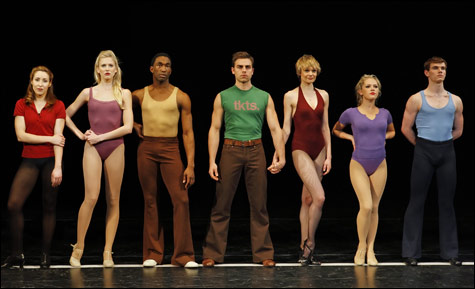
ONE SINGULAR SENSATION? The premise may be dated, but the staging continues to look great. |
In the finale of A Chorus Line, 16 dancers do a precision routine against a mirrored backdrop that makes them seem like a cast of thousands. Created by production teammates director/choreographer Michael Bennett, scenic designer Robin Wagner, and lighting designer Theron Musser, this is one of the all-time great images of the musical stage. In the touring edition of the show now at the Opera House (through 12 October), it’s been re-created under the direction of Bennett’s long-time associate Bob Avian, and it still glitters.
The show-biz gypsy’s highest aspirations are ironically fulfilled in this glamorous but banal chorus of high-shouldered, hat-doffing kicks and anonymity. A Chorus Line has no plot, really, only the stories of the hopefuls as they’re put through their paces by a hardbitten director, Zach, and his dance captain, Larry. The initial workshop process, during which Bennett coaxed real chorus dancers to pour out the painful personal stories that were developed into the script, has become as much of a legend as the show itself.
A Chorus Line isn’t about the great American success story — a star-is-born sort of thing. Instead, it’s about modest talent, hardship, desperation, getting old, and what you do for love. More than three decades after its premiere, the show is still entertaining, but I’m not sure the triumph of the little guy is still a poignant theme. Or that even dancers do anything for love any more.
The show begins with a stageful of boys and girls [sic] in practice clothes running through dance combinations as Zach scans them to make the first cut. They sing about how they need this job, but what we learn as Zach interviews them is that they probably don’t need the money so much as the personal validation. They’ve all constructed some identity for themselves, and dancing is what makes them feel real.
In 1975 we didn’t know much about teenage sexual experiments, abusive parenting, surgical body enhancement, or the homosexual underground — at least, nobody talked about those things in a mainstream show. Under Zach’s sadistic prodding, the auditionees reveal these intimacies as part of their tryout. Their stories now seem not quite ordinary but not quite shocking, either. As played by Michael Gruber, Zach seems more sympathetic, almost likable, and — miked to the max — the show plays for its surface glamor and expertise rather than its darkness.
There are funny and moving performances, as the applicants reveal what dancers go through. The tough Puerto Rican girl Diana Morales (Gabrielle Ruiz) remembers improvisation classes when she was supposed to feel the motion of an imaginary bobsled or become an ice cream cone (“Nothing”). Sheila (Emily Fletcher), Bebe (Pilar Millhollen), and Maggie (Hollie Howard) tell how they found their individual escapes “At the Ballet.” Mike (Clyde Alves) demonstrates his eclectic training (“I Can Do That”). Paul (Kevin Santos) breaks down as he tells how his parents discovered him dancing in a drag show.
The emotional heart of A Chorus Line is Cassie (Nikki Snelson), the no-longer-an-ingénue who’s given up her dream of stardom. She tries to convince Zach that she’ll be happy in the chorus, and he keeps reminding her she’s too stylish to fit in. Zach and Cassie have a history together, it turns out, but Snelson and Gruber didn’t convince me there was anything but a professional tension between them.